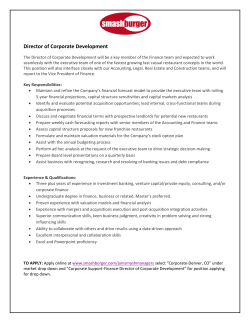
Valuation in the Fair Value Era: Focus on Quality, Risk
Valuation in the Fair Value Era: Focus on Quality, Risk BY GREG FORSYTHE INTRODUCTION Regulators, standard-setting bodies, and accounting and valuation professionals share a concern whether financial statement preparers, their valuation advisers, and auditors are equipped and qualified to engage in the various aspects of estimating and auditing fair value measurements. Amid a rapidly changing climate and increasing complexity in the financial marketplace, that concern is only growing. How companies establish the fair value of EDUCATION AND ENHANCING QUALITY assets, liabilities and equity for financial Regulators, reporting purposes is a rapidly evolving valuation specialists share the desire and area. The speed and breadth of this need for greater clarity and understanding evolution are compelling public companies of fair value requirements and processes; to interests often expressed as a call for provide higher measurements than quality fair in past, the value and accountants, standards. But auditors standards are and not a measurements and disclosures that are panacea. Unless those who perform, review more and use valuations are properly educated, consistent, supportable and auditable. the process will remain vulnerable to error and misapplication. But meeting these demands isn’t easy. Fair value measurements can be complex and Accountants confounding, particularly when no market understand valuation and fair value. Many analogue exists that can be used to help valuation providers can be more qualified estimate the fair value of an entity’s assets, for liabilities, or equity. Moreover, regulators valuation techniques more consistently. are scrutinizing financial statements for fair And government authorities can recognize value issues. This attention is creating the pressure the unintended consequences — potentially corporate financial structure to an entity’s resulting from the rules they impose on management, board of directors, valuation businesses. This convergence of interests specialists and external auditors. offers significant common ground for these that pushes throughout their and roles potential auditors and can apply stresses better established — including groups to strive for higher quality fair value measurement in financial reporting through appropriate standard-setting and Produced by Greg Forsythe, CFA, ASA, director, Financial Advisory Services LLP and leader of the Deloitte Center of Valuation Excellence. 1 Valuation in the Fair Value Era: Focus on Quality, Risk regulatory actions, particularly in the following areas: additional stresses. For example, consider the goodwill impairment test.* In Conceptual underpinnings: this analysis, assume that the For carrying value of an entity’s reporting various reasons, when developing the unit, which is not publicly traded, is $100 concepts million. Fair value measurements can underpinning fair value measurements for financial reporting often purposes, standard- reasonable range, and sometimes the setters focused primarily on frequently reasonable range for the fair value of the traded financial instruments. These fair reporting unit can straddle the $100 value measurements can be developed million carrying value. The need for a using “Level 1” inputs developed from point estimate in such a situation to quoted prices in active markets. “Level comply with the accounting standard can 2” measurements leverage market data create from reverberate throughout an organization, the similar observable accounting assets data. and Some indirectly assets and only be estimated additional stresses within that a can from auditors to valuation providers to liabilities, however, involve “Level 3” executives who ultimately inputs because they aren’t bought or accountable for the conclusions. stand sold in the marketplace and have no direct market analogues. Consequently, demonstrating that Level conform inputs concern for regulators, investors and the inputs “market other users of financial statements is the participants” would use relies heavily on potential for management bias in fair analogy and indirect evidence. Methods value to value some of these assets, liabilities Level 3. With the heightened focus on and equity instruments are also still fraudulent activity in recent years and evolving in the gradual understanding that many to 3 Management bias: Another increasing many instances as the measurements, variables the marketplace values such assets and measurement—variables that are often liabilities when there is no market for provided by company management or them. It is easy to see why significant based on “professional judgment” of the measurement valuation professional employed by the and into a fair in valuation profession tries to mimic how uncertainty go particularly value inconsistency can arise in fair value company—heightened measurements in this category, and why scepticism stresses can build up in the financial auditors and their fair value specialists reporting system due to the difficulty in when auditing fair value measurements. should be professional employed by auditing such measurements. TRYING YEARS The accounting accounting framework: framework has The Scandals, crises and growing accountability caused demands have triggered a demand for Produced by Greg Forsythe, CFA, ASA, director, Financial Advisory Services LLP and leader of the Deloitte Center of Valuation Excellence. 2 Valuation in the Fair Value Era: Focus on Quality, Risk higher quality fair value measurements, value provided required in the coming years. by better qualified valuation measurements, much more is practitioners. The consistent application of valuation standards foundation for However, fully is an achieving important this By focusing attention on these issues, goal. publicly listed companies with significant the fair value requirements in their financial expectations of the environment within reporting can address audit and regulatory which fair value measurements are used is risks, crucial for those wishing to be involved. investment community, and, ultimately, While much has been achieved in the last increase their enterprises’ value in the decade toward improving the quality of fair market place. understanding enhance their credibility in the Produced by Greg Forsythe, CFA, ASA, director, Financial Advisory Services LLP and leader of the Deloitte Center of Valuation Excellence. 3
© Copyright 2025


















